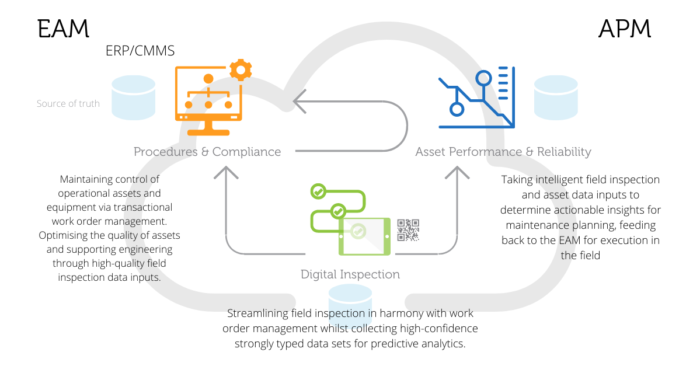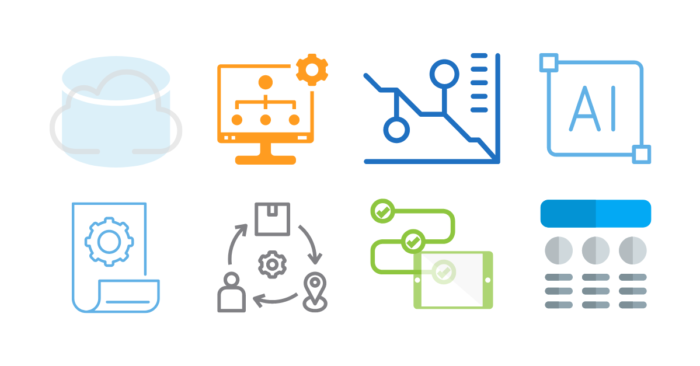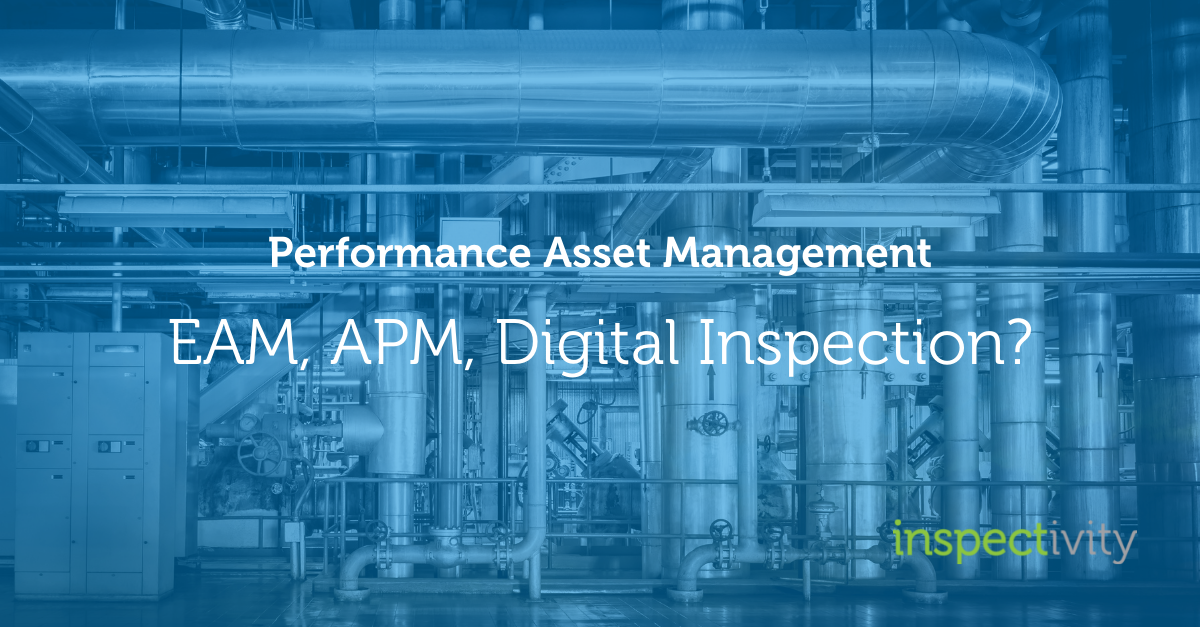In this Q&A article, we explain how digital inspection fits within the myriad of systems and processes supporting asset management for critical infrastructures. In particular, Enterprise Asset Management (EAM) and Asset Performance Management (APM).
EAM vs APM?
IBM describes Enterprise Asset Management (EAM) as “a combination of software, systems and services used to maintain and control operational assets and equipment. The aim is to optimise the quality and utilisation of assets throughout their lifecycle, increase productive uptime and reduce operational costs”. EAM is centred around the ERP or CMMS with functions for asset equipment registers, maintenance and task planning, work order management, and commercial and people/resource concepts. The EAM is the source of truth.
APM sits beside EAM to consume the transactional aspects of work order management, understanding changes to the asset hierarchy to provide predictive forecasting and reliability-centred maintenance schedules.
EAM is managing operational viability and compliance whilst APM is taking intelligent inputs to determine actionable insights for maintenance planning, feeding back to the EAM for execution in the field.

For the most part operators of critical assets are fairly mature in EAM implementation but now many are adding APM to their asset management landscape however it is still very early days with a much lower uptake. Deloitte estimated (2019) that about 5 per cent of companies have achieved an APM program. We expect that level of take up has accelerated further in the last 3 years.
What is the difference between EAM and CMMS?
Many see the EAM as part of the wider CMMS or ERP system which is responsible for centralising information to facilitate and automate maintenance management processes but the EAM has a more focused role. EAM is an asset lifecycle management approach that supports asset performance from acquisition to disposal.
EAM includes activities such as:
- Asset lifecycle management
- Work order management
- Inventory management
- Facility management
- Predictive maintenance
- Reporting and analytics
Why is EAM Important?
EAM is important for asset owners because it helps operators to understand asset condition, reliability and sustainability. It provides a set of systems and processes to analyse, assess and maintain assets. Critically EAM helps organisations to predict future reliability issues and to plan risk approaches to maintenance that are based on high-quality data inputs. The key drivers for implementing an EAM strategy are:
- Asset data – The CMMS is a key element of the EAM providing a central repository for all data relating to operational assets. A hierarchical structure provides the ability to see all information about the asset, understand key maintenance task frequency and manage the asset through enterprise workflows.
- Issue management – Maintaining equipment relies on a discrete understanding of issues/non-conformances/defects in order to plan preventive maintenance routines accordingly.
- Monitoring – EAM gathers vast amounts of data relating to assets, issues and maintenance workflows. Data collected is then catalogued and made accessible to engineering for continuous improvement and planning.
- Reliability and sustainability – EAM’s central goal is to ensure continuous operations where possible and to improve the longevity of assets. This is achieved through the collection of high-quality data from a variety of sources such as IoT and traditional inspection. This driver also addresses the need to extend the life of assets through risk assessment methodologies.
- Future complexity – The future for asset owners presents significant challenges and unknowns with regards to reputation, compliance, safety and environment. EAM practices and modern data collection can increase confidence in the inputs for risk decisions and improve the ability to meet and exceed corporate goals.
- Standardisation – EAM helps companies achieve consistent, repeatable and standardised asset management processes across any asset class.
What are the key features of EAM?
EAM is wide in scope and consists of both technical systems, well-defined business processes and expert engineering know-how. From a system point of view it has a number of critical aspects:
- A single of source of truth for all asset information and for the coordination of maintenance workflows such as work order creation and follow up work.
- A central repository of lifecycle documentation such as engineering specifications, drawings, certificates and OEM data.
- Maintenance management with a focus on more advanced management strategies such as condition-based or predictive rather than corrective maintenance and also ensuring that planning for inspection (ie. frequency) is based on high-quality data inputs.
- Supply change management to ensure parts and spares are maintained effectively. Also provides oversight of test equipment to ensure critical tools are calibrated, in service and in date.
- Change management processes to provide visibility to all stakeholders and support quality goals.
- Safety and environment stakeholders should be “linked” to field teams to allow real-time notifications and to ensure KPIs can be monitored by senior management.
- Fieldworker connectivity with mobile devices and smart data collection applications.
- Equipment tagging such as encoded human-readable labels (QR, 2D) or RFID tags, ensures a direct link between assets and systems.
- Monitoring via business intelligence systems and real-time visualisations. Dashboarding strategies for all levels of stakeholder and analysis.
- Engineering teams should have access to strongly typed data sets of asset condition information, inspection history, issue data, and media.
- Cloud deployment models to support dynamic infrastructure, modern security models and simpler integration of vendor applications (eg. AWS Landing Zones/Control Towers).

What does APM involve?
Gartner says Asset performance management (APM) encompasses the capabilities of data capture, integration, visualisation and analytics tied together for the explicit purpose of improving the reliability and availability of physical assets. APM includes the concepts of condition monitoring, risk assessment, predictive forecasting and reliability-centred maintenance (RCM).
An APM program starts with an evaluation of all required parameters to address reliability, integrity, corrosion, and performance for all mechanical equipment. It includes systems to model maintenance interventions at various frequencies based on intelligent algorithms and a wide range of high-quality data inputs. APM systems also have the ability to trigger work orders in the EAM based on asset health thresholds being reached.
Are there different maturities of APM implementation?
APM is not a recent concept. According to GE it has been actively used for more than 20 years but APM comes in different flavours or levels of maturity:
- Reactive maintenance – Represents a lack of planning and a break-fix approach (corrective maintenance).
- Preventative maintenance – Driven by engineering or compliance requirements.
- Condition-based maintenance – Performed when monitoring indicates equipment operating characteristics have deviated from design.
- Predictive maintenance – Essentially discovering maintenance options for the future through calculated asset health.
More advanced APM is taking shape in the manufacturing sector with Digital Prescriptive Maintenance and Collaborative Excellence (a collaboration between maintenance/operations/supply/safety). Essentially involves the diagnosis of events before they occur through a combination of IoT, Big Data and Dynamic Case Management. For a deeper dive read Pega’s Manufacturing Whitepaper.
Where does inspection participate in EAM and APM?
ERP/EAM systems provide a transactional platform to support the work management process. A significant proportion of the work is maintenance based inspection programs including operator rounds, compliance, safety, visual condition monitoring and much more. Through inspection the EAM is:
- Gathering vast amounts of data relating to assets and maintenance workflows.
- Maintaining critical mechanical equipment.
- Ensuring asset longevity by gathering discrete data about asset integrity issues (ie. corrosion, coating, structural).
- Supporting the integrity of inspection test equipment (ie. re-calibration).
- Collecting and cataloguing data, making it accessible to engineering for continuous improvement and planning.
Similar to EAM and integral to APM is the collection of a rich, strongly typed data set of asset condition information. Information collected by inspection plays an important role in the processing of complex rule algorithms that underpin asset performance management, providing predictions on “next inspection” frequency. The inputs or available data are typically from inspection programmes but also (as we look to the future) from more automated means such as IoT.
What are the benefits of digital inspection?
Digital inspection provides both quantitative and qualitative benefits.
Significant improvements in efficiency can be achieved by integrating work order management from the EAM with an asset-centric digital inspection platform. Man-hour savings of 50% or more are achievable across the lifecycle of an inspection:
- Preplanning for inspection is mostly a wasteful data-mining exercise to gather engineering data and previous inspection records. A digital system automates this process.
- Fieldwork is streamlined by ensuring all information and digital tools required by the inspector are available at their fingertips in a convenient viewport.
- Reporting with an integrated digital inspection platform means that as soon as the inspector completes the data capture in the field, the work order in the EAM is updated. Stakeholders can access real-time results and man-hours typically associated with report preparation can be re-allocated to more important value-adding tasks.
Even more important are the qualitative outcomes.
Before, we highlighted the EAM is harnessing inspection data to make it catalogued and accessible to engineering. In many EAM implementations asset condition data ends up in non-parseable flat files that are only loosely coupled with the original work order (ie. PDF inspection report). This is the reality for most EAM implementations. The data is hardly accessible.
Furthermore, paper-based approaches are non-standardised, they are typically a collection of subjective assessments with a value that is strongly aligned with seniority and experience. “Experience” that is extremely difficult to “resource” (in particular in a post-Covid marketplace). By standardising the process, less experienced field teams can benefit from the tribal knowledge that is quickly being lost as the more “qualified” hang up their inspection hats.
Integral to APM is the collection of a rich and strongly typed data set. It is through high-confidence data that accurate predictions can be achieved. Many APM systems provide first-class algorithms to predict future maintenance strategies however many are equally guilty of taking input from subjective manual inspection assessments. Digital inspections collect data with strongly typed forms that avoid the “garbage in, garbage out” scenario by removing subjective verbose assessments.
Digital inspection democratises data collected, providing a catalogued and accessible data set for all stakeholders, not just the inspection team. Downstream engineering, senior management, compliance, environmental, safety and statutory authorities can all leverage the data in real-time.

APM is focused on mechanical integrity whereas EAM has a much wider scope. A separate digital inspection platform provides the ability to simplify data collection and inspection management across a much wider range of maintenance activities and disciplines. With a single agnostic digital system you can achieve two important goals:
- Connect field inspection activities with work order management in the EAM; and
- Provide high-quality data inputs to APM rule engines
Finally, data collected by inspections is voluminous and this type of “digitally collected data set” can form the basis for future automation outside of the scope of current EAM and APM implementations. The potential for this data is significant and without collecting it we may lose significant future opportunities.
About Inspectivity
Inspectivity is an Australian SaaS company assisting operators, EPCs and service providers to collect rich asset condition data sets through digital inspection. The Inspectivity platform is a no-code software toolkit for the configuration of any asset-centric enterprise inspection use case. Combining modern web and mobile apps to connect global teams and supercharge inspection outcomes. Inspectivity’s approach to digital asset inspection provides a standardised, repeatable, and scalable inspection methodology to improve reliability, sustainability and quality control for critical assets. Delivering benefits across the full project lifecycle: design, construction, commissioning and operations. One solution for any project, phase of work, or inspection discipline.
If you would like to learn more about Inspectivity’s digital toolkit for the configuration and management of any asset-centric enterprise inspection use cases please contact us.
+61 (0) 8 6160 6060 sales@inspectivity.com
